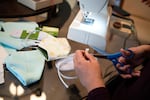This weekend marked a year since the first case of COVID-19 was confirmed in an Oregon resident.
The first known patient was Hector Calderon, a janitor at a Lake Oswego elementary school who fell ill last February and was treated at the Kaiser West Side Medical Center.
Calderon was the first confirmed case, but almost certainly was not the first person infected with COVID-19 in Oregon.
Subsequent research that studied blood bank samples found the virus may have been circulating in the state as early as December 2019.
Calderon survived, but a year later, more than 2,200 Oregonians have died of COVID-19.
“Our hearts are with the families who have lost loved ones to this deadly disease,” said Gov. Kate Brown in a press release marking the anniversary.

Oregon Gov. Kate Brown speaks during a news conference on the coronavirus outbreak, March 16, 2020.
Kaylee Domzalski / OPB
But she also noted that Oregonians have successfully blunted the impact of the global pandemic.
Oregon has the country’s 4th lowest death rate from COVID-19, according to the Centers for Disease Control and Prevention.
Only Hawaii, Alaska and Vermont have fewer deaths in proportion to their populations.
“Because of your smart choices to protect friends and family, Oregon has maintained some of the lowest infection, hospitalization, and death rates in the nation throughout the pandemic,” Brown said.
Brown encouraged Oregonians to continue wearing masks, avoiding large indoor gatherings, and staying home when sick.

Aurora Oliva Ma of Beaverton, Ore., sews DIY protective face masks using materials purchased from JoAnn Fabrics at her home on March 19, 2020. Oregon Health & Science University officials say, for now, they are researching effective materials and sewing patterns people could use to sew masks for them.
Arya Surowidjojo / OPB
The number of COVID-19 cases are decreasing in Oregon.
One key indicator in the state’s most recent COVID-19 trend report is particularly encouraging. So far in 2021, the virus’s so-called effective reproductive number, Re, has fallen slightly below 1. That means that on average, each person with COVID-19 is infecting just one other person or no one at all.
When the reproductive value of a virus drops below one, new cases will decline.
However, the state’s epidemiologists warn that changes in human behavior — fewer people wearing masks, for example — could easily reverse that progress.
And so could the new, more contagious variants of the virus that are circulating in the United States.
